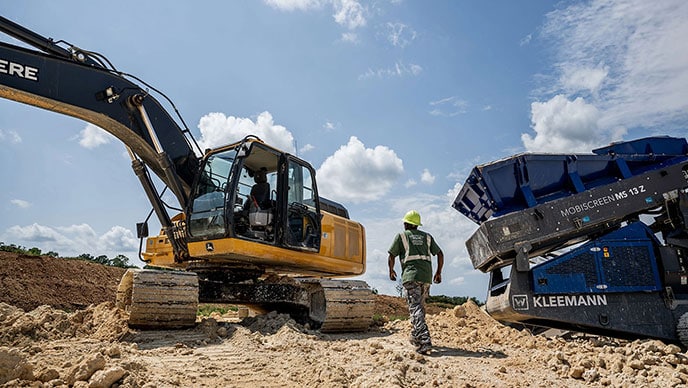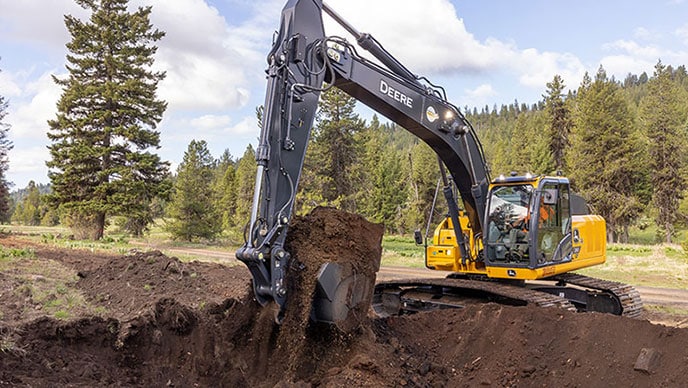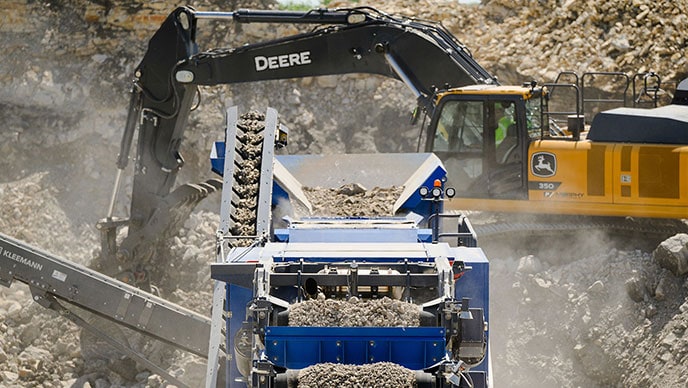ALL ABOUT JOHN DEERE WHEEL LOADERS: PRIMED FOR PRODUCTIVITY
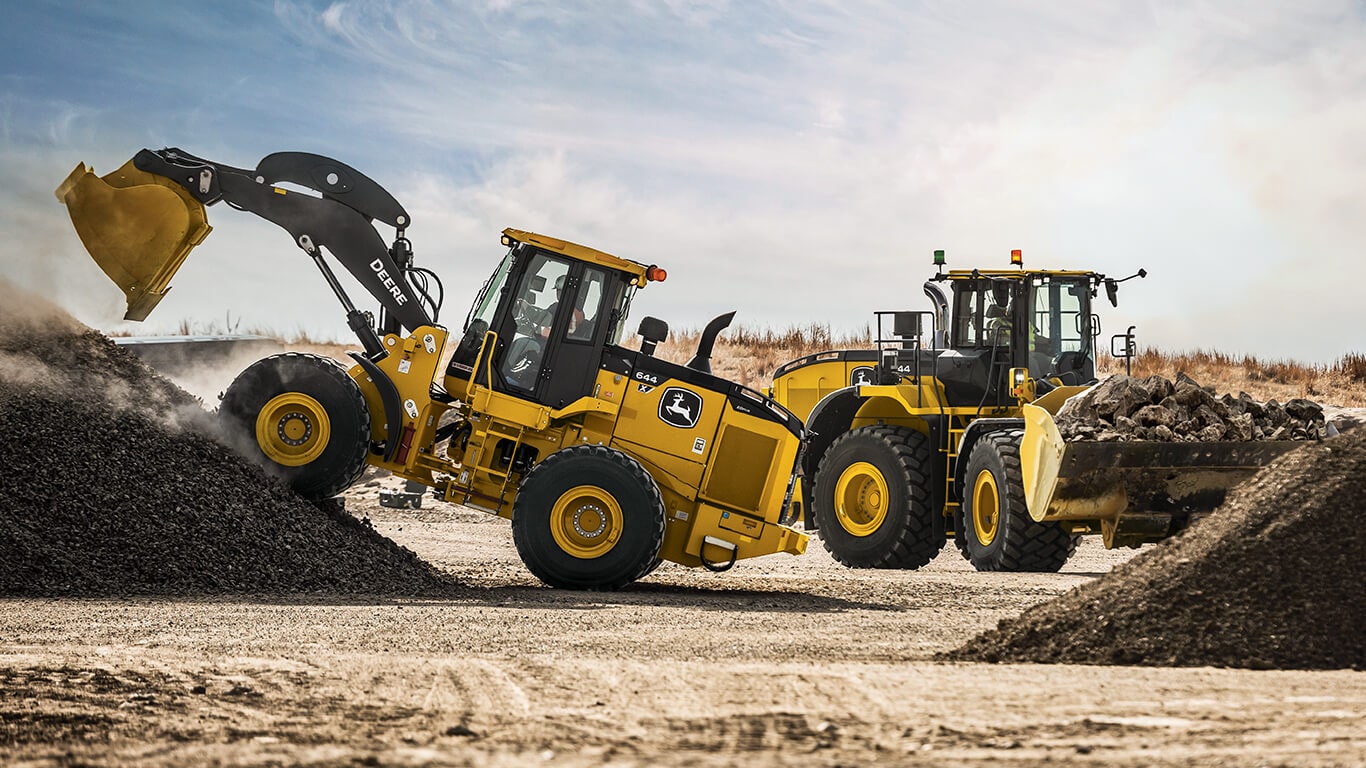
When it comes to material handling and productivity, wheel loaders are the backbone of any jobsite. These powerful machines are designed to move large volumes of materials quickly and efficiently, making them indispensable for projects of all sizes. Built to deliver performance, durability, and operator comfort, John Deere Wheel Loaders can help you get the job done efficiently. Let's explore their capabilities.
What is a wheel loader?
Wheel loaders are powerful, heavy-duty machines designed for lifting, loading, and transporting materials. Featuring a large front-mounted bucket attached to hydraulic arms, they excel at scooping, lifting, and moving materials like soil, gravel, sand, and debris. Operators can also swap out the bucket for a variety of attachments, increasing their versatility.
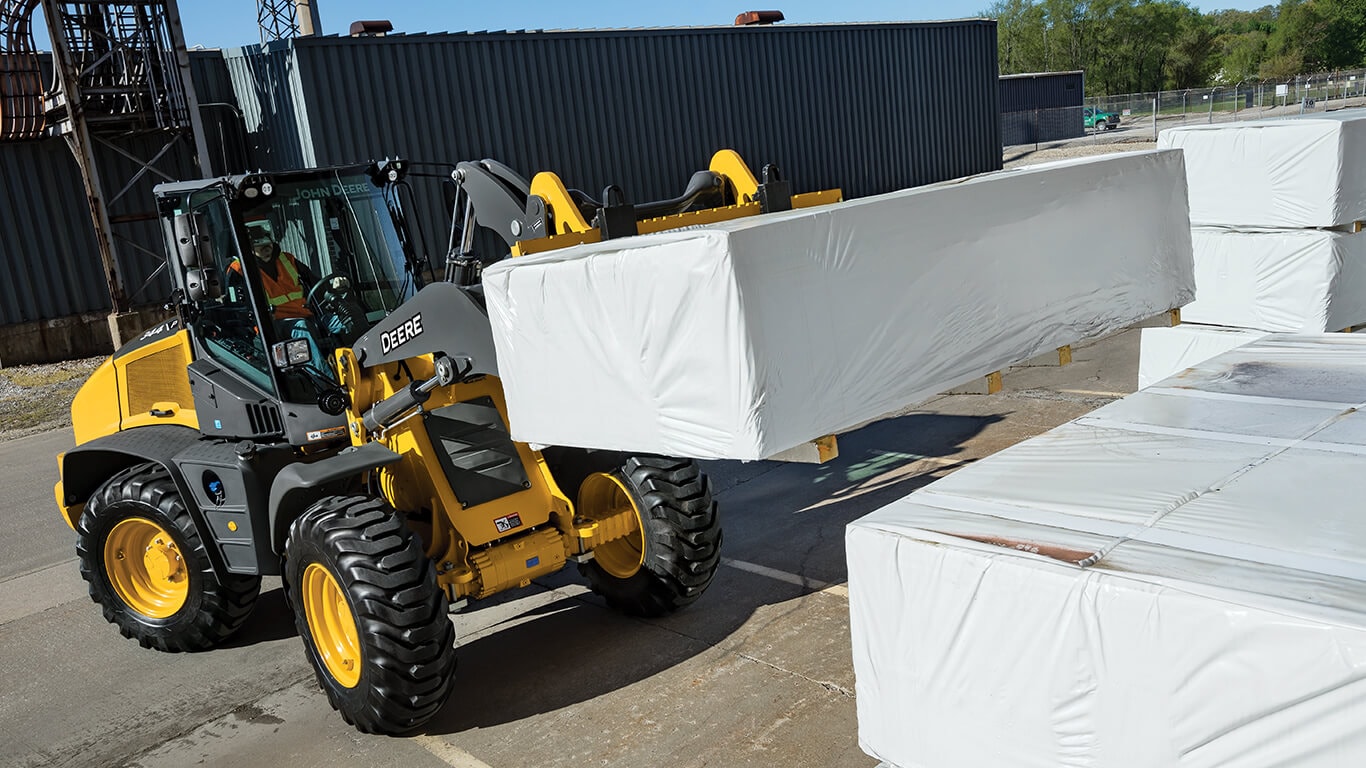
What are common uses for wheel loaders?
Some top wheel-loader applications include:
- Site preparation and earthmoving
- Aggregate and material handling
- Demolition and debris removal
- Road construction and maintenance
- Excavation support and backfilling
- Utility and pipeline installation
- Bridge and infrastructure projects
- Industrial and warehouse material transport
What makes John Deere Wheel Loaders so popular?
Built for strength and reliability, John Deere Wheel Loaders deliver exceptional performance with hydraulic controls, powerful engines, and intelligent features designed to enhance efficiency. These machines are engineered to handle heavy workloads while maintaining fuel efficiency and reducing downtime. Plus, John Deere's extensive dealer network provides world-class support with service plans, parts availability, and expert technicians.
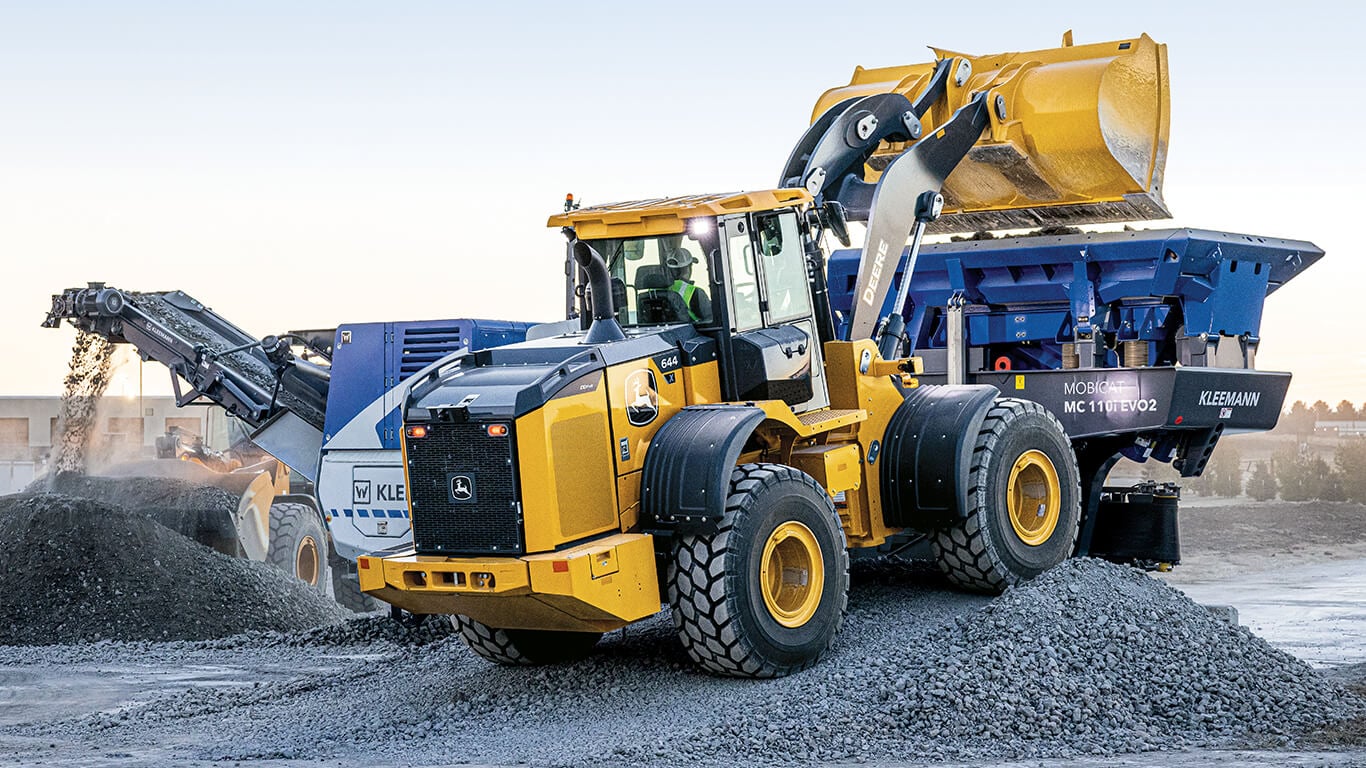
Wheel loaders for every job
John Deere offers a variety of wheel loaders in different sizes to match specific job requirements:
- Compact wheel loaders (61-103 hp)
- Mid-size wheel loaders (124-264 hp)
- Large wheel loaders (303-536 hp)
Equipped with the latest innovations
John Deere Wheel Loaders are built with brains to leverage the brawn. Technology solutions like John Deere Operations Center™ and John Deere Precision Construction tools are designed to streamline your operations, minimize rework, maximize uptime, and more.
- John Deere Operations Center: Analyze critical machine data, track utilization, review diagnostic alerts, and more with John Deere Operations Center. Connected machines enable you to manage your fleet from your desktop or mobile device, giving you remote access to machine hours and location, fuel consumption, idle time, maintenance reminders, and more.
- John Deere SmartDetect™: Conditions change daily, making jobsite awareness a top priority. John Deere SmartDetect technology utilizes a combination of cameras, radar, and machine learning to enhance situational awareness. This optional intelligent system helps operators detect obstacles to help increase safety for workers and equipment.
- SmartWeigh™: Operators can load more accurately and without rework with SmartWeigh, the real-time, payload-weighing, add-on solution for mid-size and large wheel loaders. For example, the 904 P-Tier Wheel Loader can load standard, over-the-road trucks in just two passes, helping you maximize jobsite efficiency and boost your bottom line.
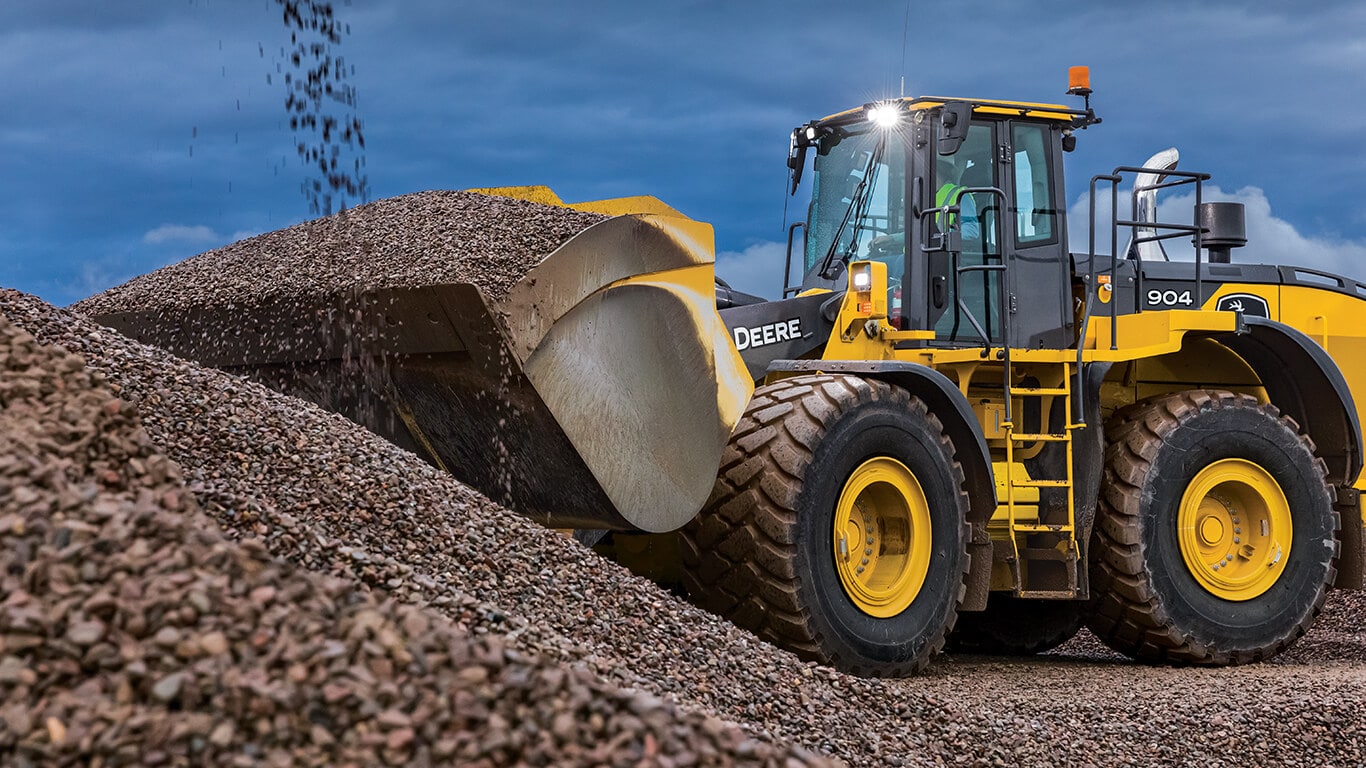
How do you choose the right John Deere Wheel Loader for the job?
John Deere's Performance Tiering system ensures you get the right equipment for your specific needs. Explore our full range of tiered models — each designed to deliver the ideal balance of performance, comfort, and value for your jobs.
- G-Tier: Economical, rugged, and reliable machines designed for light- and medium-duty work while maintaining dependable results.
- P-Tier: High-performance machines with advanced comfort and efficiency, built to handle heavy-duty jobs and deliver consistent productivity.
- X-Tier: Advanced technology and top-tier performance, efficiency, and comfort for maximum productivity every day.
| COMPACT MODELS | NET POWER | BUCKET CAPACITY | OPERATING WEIGHT |
|---|---|---|---|
|
33 kW (44 hp) at 2,200 rpm |
0.7–1.1 m3 (0.9–1.4 cu. yd.) |
4840 kg (10,670 lb.) |
|
|
47 kW (62 hp) at 2,200 rpm |
0.7–1.1 m3 (0.9–1.4 cu. yd.) |
5220 kg (11,508 lb.) |
|
|
53 kW (72 hp) at 2,200 rpm |
0.7–1.1 m3 (0.9–1.4 cu. yd.) |
5920 kg (13,051 lb.) |
|
|
52 kW (71 hp) at 2,400 rpm |
0.8–1.1 m3 (1.0–1.4 cu. yd.) |
5560 kg (12,258 lb.) |
|
|
52 kW (71 hp) at 2,400 rpm |
0.8–1.6 m3 (1.0–2.1 cu. yd.) |
6400 kg (14,110 lb.) |
|
|
52 kW (71 hp) at 2,400 rpm |
0.8–2.0 m3 (1.0–2.6 cu. yd.) |
6400 kg (14,110 lb.) |
|
|
76 kW (103 hp) at 2,000 rpm |
1.5–2.0 m3 (2.0–2.6 cu. yd.) |
8860 kg (19,533 lb.) |
| MID-SIZE MODELS | NET POWER | BUCKET CAPACITY | OPERATING WEIGHT |
|---|---|---|---|
|
92 kW (124 hp) at 2,100 rpm |
1.9–3.4 m3 (2.5–4.5 cu. yd.) |
11 709 kg (25,814 lb.) |
|
|
92 kW (124 hp) at 2,100 rpm |
1.9-2.1 m3 (2.5-2.75 cu. yd.) |
11 289-11 941 kg (24,887-26,325 lb.) |
|
|
113 kW (152 hp) at 1,800 rpm |
1.9–3.4 m3 (2.5–4.5 cu. yd.) |
13 123–13 163 kg (28,931–29,018 lb.) |
|
|
125 kW (168 hp) at 1,800 rpm |
2.1–2.3 m3 (2.75–3.00 cu. yd.) |
12 993–13 556 kg (28,646–29,886 lb.) |
|
|
123 kW (166 hp) at 1,700 rpm |
1.9–4.0 m3 (2.5–5.25 cu. yd.) |
13 844–13 879 kg (30,520–30,598 lb.) |
|
|
143 kW (192 hp) at 1,600 rpm |
1.9–4.0 m3 (2.5–5.25 cu. yd.) |
15 747–15 790 kg (34,715–34,810 lb.) |
|
|
169 kW (227 hp) at 1,800 rpm |
3.1–3.2 m3 (4.00–4.25 cu. yd.) |
17 934–18 205 kg (39,537–40,135 lb.) |
|
|
186 kW (249 hp) at 1,800 rpm |
3.1–3.6 m3 (4.0–4.75 cu. yd.) |
18 709–18 744 kg (41,246–41,324 lb.) |
|
|
172 kW (231 hp) at 1,500 rpm |
3.1–3.6 m3 (4.0–4.75 cu. yd.) |
18 856–18 892 kg (41,571–41,649 lb.) |
|
|
200 kW (268 hp) at 1,800 rpm |
3.1–3.8 m3 (4.0–5.0 cu. yd.) |
19 825–19 859 kg (43,707–43,783 lb.) |
| LARGE MODELS | NET POWER | BUCKET CAPACITY | OPERATING WEIGHT |
|---|---|---|---|
|
236 kW (316 hp) at 1,500 rpm |
3.8–4.5 m3 (5.0–5.85 cu. yd.) |
24 907–26 630 kg (54,920–58,709 lb.) |
|
|
243 kW (325 hp) at 1,500 rpm |
3.8–4.5 m3 (5.0–5.85 cu. yd.) |
25 639–26 883 kg (56,524–59,267 lb.) |
|
|
256 kW (343 hp) at 1,600 rpm |
3.8–5.2 m3 (5.0–6.75 cu. yd.) |
26 460–28 101 kg (58,334–61,952 lb.) |
|
|
264 kW (354 hp) at 1,600 rpm |
4.0–5.35 m3 (5.25–7.0 cu. yd.) |
27 213–28 504 kg (59,994–62,840 lb.) |
|
|
311 kW (417 hp) at 1,400 rpm |
4.8–6.1 m3 (6.3–8.0 cu. yd.) |
33 439–33 851 kg (71,516–74,629 lb.) |
|
|
320 kW (429 hp) at 1,400 rpm |
7.1–7.5 m3 (9.3–9.8 cu. yd.) |
35 335–35 727 kg (77,900–78,765 lb.) |
|
|
400 kW (536 hp) at 1,600 rpm |
6.5–7.65 m3 (8.5–10.0 cu. yd.) |
54 253–56 524 kg (119,607–124,614 lb.) |
Choosing the right equipment is just one step toward getting your work done efficiently. Our world-class dealer support provides you with the support of experienced technicians, parts when you need them, and more. Making the most of our dealer network is one of the easiest ways to decrease costs, increase uptime, and stay on top of your operation.
Ready to add John Deere Wheel Loaders to your fleet? Contact your local John Deere dealer for details today.
